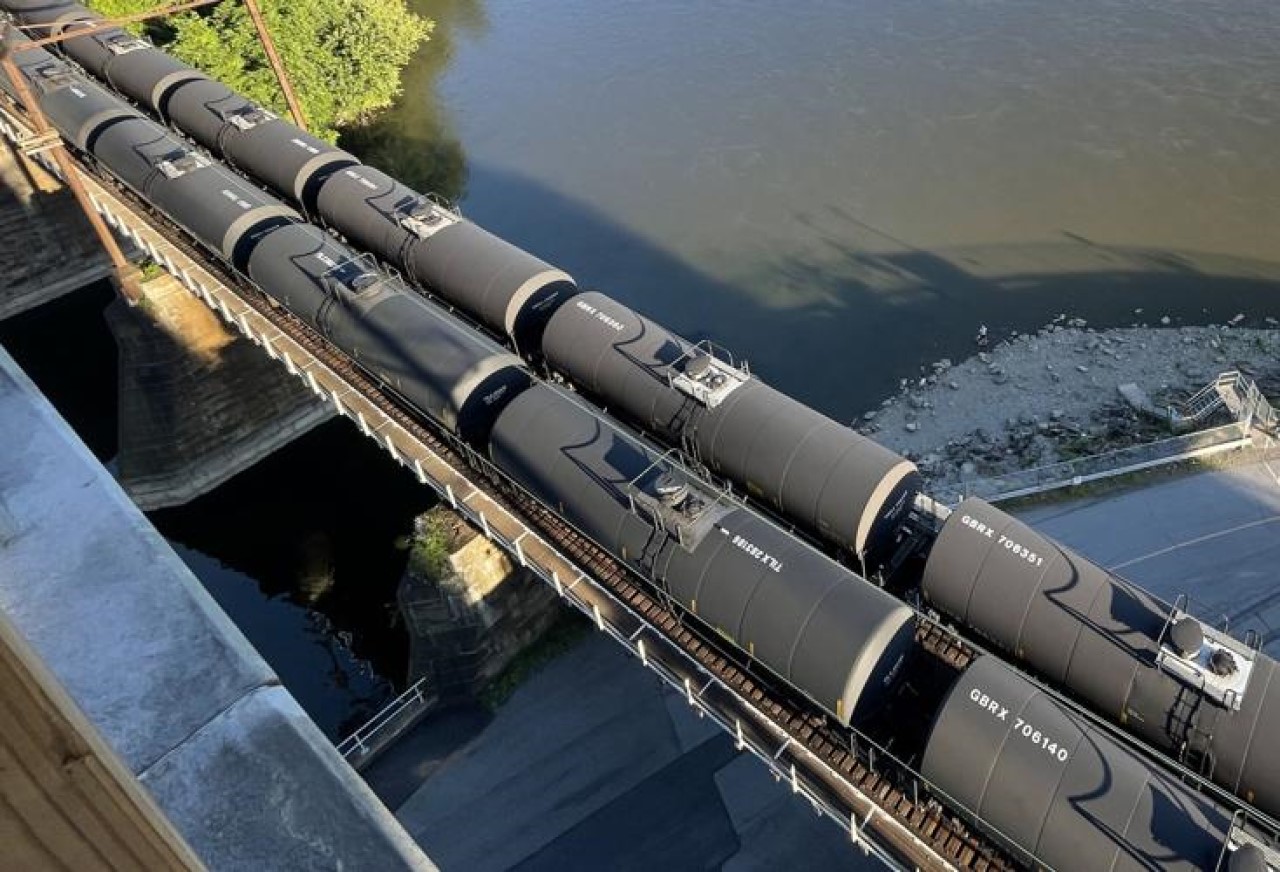
A pair of trains with tank cars sit on Norfolk Southern railroad line along the Susquehanna River at Safe Harbor June 5, 2022.
Blaine Shahan / LNP | LancasterOnline

A pair of trains with tank cars sit on Norfolk Southern railroad line along the Susquehanna River at Safe Harbor June 5, 2022.
Blaine Shahan / LNP | LancasterOnline

Blaine Shahan / LNP | LancasterOnline
A pair of trains with tank cars sit on Norfolk Southern railroad line along the Susquehanna River at Safe Harbor June 5, 2022.
At least 28 hazardous materials moved by train through Lancaster County in 2021, the most recent year for which that data is available in county officials’ commodity reports. The U.S. Department of Transportation defines hazardous material as “any materials that, because of quantity, concentration, or physical or chemical characteristics, pose a significant present or potential hazard to human health and safety, or to the environment, if released.
Here is a list of the hazardous materials included in the county’s report:
Hazmat Commodity: Acrylic Acid, Stabilized
Common use: Production of plastics
Risk: Skin irritation, eye irritation
Hazmat Commodity: Alcohol, NOS (not otherwise specified)
Common Uses: Can have multiple uses including as an additive or solvent.
Risk: Flammable
Hazmat Commodity: Ammonium Nitrate
Common uses: In the making of fertilizer. In the making of explosives
Risk: Can intensify fires. Toxic inhalation risk
Hazmat Commodity: Anhydrous Ammonia
Common uses: In the making of fertilizer. Also, commonly used to make other compounds react with other things such as cleaning agents.
Risk: Toxic inhalation risk
Hazmat Commodity: Carbon Dioxide
Common Use:Solid Dry Ice, liquid or gas
Risk: Asphyxiation
Hazmat Commodity: Chlorine
Common Use: Water treatment for disinfection
Risk: Toxic inhalation risk
Hazmat Commodity: Combustible Liquids, NOS (not otherwise specified)
Common Use: N/A. This could be any type of combustible liquid that does not fall under another classification.
Risk: Flammable
Hazmat Commodity: Ethanol
Common Use: Additive to gasoline, solvent for many chemicals.
Risk: Flammable
Hazmat Commodity: Ethylene Oxide
Common Use: Production of plastics. Common starting material for other chemicals
Risk: Highly reactive. Inhalation risk-can cause cancer by reacting with DNA in body.
Hazmat Commodity: Flammable Liquid, NOS (not otherwise specified)
Common Use: N/A. This could be any type of combustible liquid that does not fall under another classification.
Risk: Flammable.
Hazmat Commodity: Hydrochloric Acid
Common Use: Muriatic Acid. Pickling of steel.
Risk: Corrosive-chemical burn. Can give off toxic fumes.
Hazmat Commodity: Hypochlorite Solution
Common Use: Bleach. Cleaning and disinfecting
Risk: Skin irritation
Hazmat Commodity: Isobutane
Common Use: Solvent. Starting material for other chemicals.
Risk: Boiling Liquid Expanding Vapor Explosion
Hazmat Commodity: LP Gas (Liquid Petroleum Gas)
Common Use: Cooking, heating
Risk: Boiling Liquid Expanding Vapor Explosion
Hazmat Commodity: Methanol
Common Use: Additive to gasoline
Risk: Flammable
Hazmat Commodity: Methyl Methacrylate
Common Use: Production of plastics
Risk: Skin Irritant
Hazmat Commodity: Pentane
Common Use: Blowing agents in manufacture of polystyrene
Risk: Fire
Hazmat Commodity: Petroleum Crude Oil
Common Use: Fuel
Risk: Flammable. Also, if spilled especially into water source it is non soluble.
Hazmat Commodity: Phosphoric Acid
Common Use: Making of fertilizer and making additives in detergents.
Risk: Chemical burn
Hazmat Commodity: Potassium Hydroxide Solution
Common Use: Making of other chemicals.
Risk: Chemical burn
Hazmat Commodity: Propane
Common Use: Barbeque grills, powers some vehicles
Risk: Flammable. Fire. Boiling Liquid Expanding Vapor Explosion
Hazmat Commodity: Propylene
Common Use: Production of Plastics
Risk: Flammable
Hazmat Commodity: Sodium Chlorate
Common Uses: Bleaching paper. Water treatment
Risk: Irritant. Oxidizer-may cause fire or explosion.
Hazmat Commodity: Sodium Hydroxide Solution
Common Uses: Making of soaps. Drain cleaner, used in many reactions
Risk: Corrosive-can cause skin burns or irritation
Hazmat Commodity: Styrene
Common Use: Raw material for polystyrene, a type of plastic. Used in the production of plastics.
Risk: Flammable. Irritant
Hazmat Commodity: Sulfur, Molten
Common Use: Production of plastics. Making Sulfuric Acid, detergents and fertilizers.
Risk: Inhalation risk. Irritant
Hazmat Commodity: Sulfuric Acid
Common use: Commodity chemical or commonly used chemical for multiple applications, making fertilizers.
Risk: Irritant, chemical burns.
Hazmat Commodity: Vinyl Chloride
Common Use: Production of plastics
Risk: Carcinogen and Explosion hazard
We sought railroad hazmat records from 12 central Pa. counties; only 3 provided detailed lists
Hazardous material on Pa. trains: How we got the information
Who responds? When do you evacuate? A look at Lancaster County’s Hazardous Rail Transit Plan
Toxic trains: Real-time hazmat info hard to get, even for Lancaster County’s first responders

Get insights into WITF’s newsroom and an invitation to join in the pursuit of trustworthy journalism.
The days of journalism’s one-way street of simply producing stories for the public have long been over. Now, it’s time to find better ways to interact with you and ensure we meet your high standards of what a credible media organization should be.